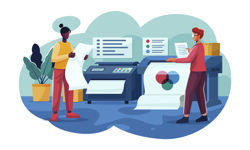Until recently, consumer magazine-based media companies were e-commerce wallflowers. They watched as fashion, food and other online retailers not only sold products from companies that are also key magazine-brand advertising clients, but muscled in on their connections with consumers by offering growing amounts of lifestyle content (trends, tips, how-to etc) to build the site traffic that translates to product sales.
Publishers’ reticence was based primarily in concerns about undermining their brands’ editorial credibility / authority - still (perhaps more than ever) a key asset / differentiator in driving consumer engagement and advertiser revenues, in this age of virtually (pun intended) infinite, albeit often suspect, information sources.
But with e-tailers increasingly employing big-gun editorial talent, often recruited from the magazine world, to manage and contribute their content, distinctions between sponsored / promotional and “independent” online content offerings are becoming blurred. Further, today’s omnichannel consumers want / expect the ability to readily link to and purchase the items they’re reading about.
Publishers recognised the need to make haste to leverage the considerable power of their brands in this arena, or risk ceding this huge opportunity to e-tailers.
Hence, they’re implementing a rapidly growing number of initiatives - in partnership with synergistic e-tailers / advertisers or even on their own - designed to enable them (where possible) to get a cut of the e-commerce action, in addition to enhancing advertisers’ cross-platform buys within their media assets. These offerings are being positioned (with valid logic — and often with appropriate disclosures) as value-added reader services.
“There is this continuum with media brands on one side and commerce brands on the other, and whether we intend it or not, we are both making steps toward the middle,” Chris Mitchell, VP / publisher for Condé Nast’s GQ, observed in a recent Folio: interview. “Not that we want to be retailers, but research suggests it provides a better user experience when they get to click through to purchase… Our primary motivation is not to be in the retail game,” he said, but to form strategic partnerships with key advertisers.
Variations on E-Tailer Partnerships / Platforms
Condé Nast is among the most aggressive players in the new e-commerce arena.
One high-profile example: Vogue’s partnership with online luxury fashion retailer Moda Operandi. Starting with New York’s spring / summer Fashion Week, readers of Vogue.com’s coverage of the runway shows could click on specific looks from the world’s leading designers and pre-order them from Moda Operandi - or order items available for immediate delivery. The plan calls for the partnership to continue with each new season’s NY fashion shows.
Another: For a time, Esquire and J.C. Penney were partners in an “editorially curated” e-commerce site, CLAD (though that was shuttered after Penney hooked up with Martha Stewart Living Omnimedia to launch Martha Stewart areas within its retail stores).
One of the latest Condé ventures is a GQ partnership with upscale retailer / longtime advertiser Nordstrom. For six months, starting with its July issue, GQ is curating an online storefront hosted on NordstromMen.com, as well as linking content on the magazine’s own site to items for purchase through Nordstrom. The “GQ Selects” items also will be featured in the print magazine.
While declining to say whether the magazine is sharing in product-sale revenue, GQ’s Mitchell confirmed to Folio: that the Nordstrom partnership is part of a larger, ongoing GQ (and no doubt Condé Nast) e-commerce strategy that began with a 2011 initiative with Gilt Groupe's Park and Bond site. Next up: a fall-timed collaboration with Bloomingdale’s.
Mitchell’s comments about the larger context of such partnerships would likely be echoed by competing publishers: "This space is evolving so quickly, and that's the reason we are looking at these six-month windows for programs like this," he said. "Our strategic interest in e-commerce may change in six months. How we structure the relationships and content partnerships may change… But we will definitely be remaining in this space of giving our readers novel ways to engage with our content and click through to purchase."
Of course, other major publishers have likewise jumped into the fray. One of Hearst’s forays: a shoppable trend guide from Elle, said to be the first social-commerce initiative through a magazine brand’s Facebook page. Accessed through a tab on Elle’s Facebook page, it enables users (through social commerce platform 8thBridge) to click into retailer sites to buy the products featured - as well as to hit “share” buttons relating to each product (like “love”, “want”, “buy”) — thereby providing free marketing exposure, as these “shares” are automatically posted on their Facebook Timelines. The first, Spring 2012 edition in this ongoing S-commerce program will be followed by more seasonal fashion guides.
Nor are fashion books alone in capitalising. Time Inc’s Real Simple bested the common practice of linking readers to e-tailers’ sites to make purchases with a Mother’s Day gift-guide app that let users buy 50 editorially curated items from multiple e-tailers directly from the app (universal shopping-cart capability), using third-party digital commerce solution DropWallet. (In this case, it’s clear that the magazine got a cut of product sales.)
Beyond partnerships, some publishers are becoming e-tailers themselves. One frequently-cited example is the push by the UK’s own Time Out Group to become a major online marketer of event tickets in all markets covered by its city guides. This is already evident here in the US with the Time Out New York brand, which is selling event tickets directly through a relaunched website and its city-guide apps (these also offer the ability to book restaurant reservations).
(Next time: a look at brand-extension innovations in co-branded / licensed products and other platforms.)










